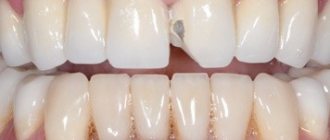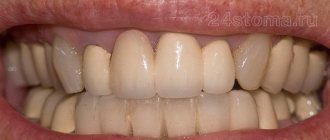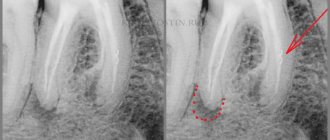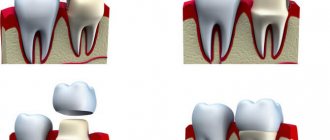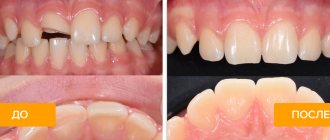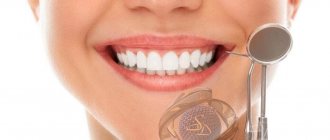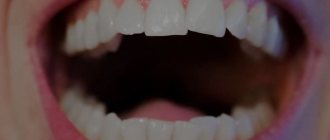Fracture of the front teeth occurs quite often in the practice of a dentist. This defect can be mild and affect only a small area of enamel, but sometimes the front tooth breaks at the root. What to do in such situations? Of course, go to the dentist. Today there are many methods that allow you to correct the problem, taking into account the individuality of each case.
Treatment of small chips
Chips on the front teeth can form for various reasons:
- Increased load on the incisors when biting off hard foods.
- Injuries, mechanical shocks.
- Lack of calcium or nutrients.
- Dental diseases that thin or destroy tooth enamel.
With small chips, most often only the hard enamel is damaged, while the tooth pulp remains intact. This is the simplest situation. To solve the problem, aesthetic dentistry methods are used:
- Restoration with filling material. The dentist selects a composite that matches the shade and transparency of natural enamel. The filling material is then applied to the tooth to restore its shape. The advantage of the filling is its low price. We use modern materials, so the restoration lasts a long time. But even high-quality composites deteriorate over time. In addition, they tend to absorb dyes. Therefore, the filling changes color over time and becomes noticeable.
- Restoration with veneers. The veneer completely covers the surface of the tooth. It covers all small defects. Installing veneers is not always justified, as this is a more expensive option compared to a filling. We recommend using it if the beauty of your smile is important to you.
Dentistry for those who love to smile
+7
Make an appointment
Types of fractures and their causes
Depending on the specific characteristics of the defect, the following types of fractures are distinguished:
- Complete and incomplete. With a complete fracture, the pulp of the tooth is necessarily exposed, the canal is often exposed, and the root may be affected, but with an incomplete fracture, only the enamel and dentin are damaged.
- Transverse and longitudinal. A transverse fracture is more favorable in terms of subsequent recovery, especially if the lower (visible) third of the tooth has broken off. Longitudinal fractures are more complex; repairing a broken front tooth in such cases is almost impossible; it often has to be removed, especially if a large part of it is damaged.
- Comminuted fractures occur when there are several lines of damage. Such situations almost always require tooth extraction.
A fracture can affect both the crown of the tooth and the root itself. In the first case, diagnosis is not a problem, because all damage is visible to the naked eye. In order to see the root fracture, it is necessary to use an x-ray.
More often, a tooth fracture occurs when a mechanical force is applied to it. These are various types of injuries (accident, fight, fall). The degree of damage can vary: from a small chip of enamel on one tooth to injury to not only the front teeth, but also the molars.
It is not uncommon for enamel chips to occur when a hard object gets caught in food. In addition, the risk of breaking off a section of the tooth or the entire crown increases sharply if there are carious lesions. In this place, the integrity and, as a result, the strength of the entire tooth is compromised, so a fracture can occur even with a slight load.
Treatment of severe chips
With such chips, not only the enamel is destroyed, but also the pulp. Typically, such defects appear as a result of injury or caries. Treatment begins with depulpation. Nerve removal is done under local anesthesia. Due to the fact that our clinic uses modern anesthetic drugs, the procedure is almost painless. After depulpation, the tooth is filled. And only when it is cured, the doctor decides how to make the restoration. There are two optimal ways:
- Veneers. Veneer allows you to restore the anatomical shape and at the same time looks natural. The tooth will be indistinguishable from natural ones. Veneers can be used even if up to half of the crown part is destroyed.
- Crowns. They are advisable to use if the tooth is severely damaged. Ceramic or metal-ceramic crowns look natural and are not noticeable in the dentition.
It is not advisable to use filling for severe chips. The seal will quickly collapse.
Chip of a pulpless tooth
The most common problem with which patients come to the clinic is a chip that affects the tooth down to the pulp.
In this case, either a crack appears on the surface or a small fragment of the tooth breaks off. Most often, such damage occurs on pulpless teeth, since they have already been subjected to dental treatment. Typically, about 50% of the surface of pulpless teeth is restored, which leads to a disruption of the mineral composition, causing the tooth to become fragile. If a crack or chip appears on a pulpless tooth, you should contact a dental clinic as soon as possible. Without treatment, food particles will penetrate through the crack, bacteria will develop there, and inflammation may occur. In this case, the tooth will begin to deteriorate even more, and pulpitis and periodontitis may develop.
In severe cases, the result of a chip will be a cyst or flux, which will require more serious and lengthy treatment; Often the tooth has to be removed. To prevent this from happening, it is better to immediately consult a doctor who will help eliminate the problem without removal. Typically, such a tooth is restored using composite inlays or a crown is installed on a pin.
Diagnostic measures
If the tooth has broken off to the gum line, the dentist will conduct an examination. He is studying:
- whether the surrounding areas are damaged;
- are there necrotic areas?
- whether blood got into the dental cavity;
- what condition are the roots in?
To clarify the situation completely, the patient is asked to undergo an x-ray. From the image you can understand whether the roots have shifted, whether the nerve fibers are damaged, and what condition the remaining solid structures are in.
What to do if the root is preserved
When preserving the roots, the doctor examines their condition and decides on the possibility of prosthetics. If the image shows that the remaining parts of the unit are inflamed, broken, or there is a cyst/granuloma near them, removal surgery is performed immediately.
After tearing out, there are only two treatment options:
- Implantation of a titanium pin and fixation of the implant on top of it. This is the most reasonable solution, since the artificial unit creates conditions for uniform distribution of the chewing load and prevents jaw atrophy.
- Installation of a dental bridge. In this case, the units located on both sides of the defect are subjected to depulpation and partially sawed off to give a suitable shape. Then a prosthesis is made, which includes three artificial crowns. He rests on the prepared stumps. After fixing the bridge, the bone tissue in which the broken tooth was fixed ceases to participate in the chewing process. Because of this, they gradually “sag.”
In most cases, the roots are suitable for prosthetics and are not removed if a tooth is fractured. Then the doctor carries out restoration:
- Fills the stump and covers it with a crown made of metal-ceramic, ceramic, zirconium oxide or metal.
- Installs a fiberglass pin or stump inlay into the remaining part and also fixes a prosthesis from the material chosen by the patient on top.
Dentures are a suitable solution for dental fractures. It returns the smile to its former aesthetics and functionality.
Dental care in Moscow
In order to efficiently and inexpensively restore a broken or chipped tooth, contact our clinic.
We use:
- innovative treatment methods that allow you to achieve ideal results in the shortest possible time;
- durable, biocompatible materials, thanks to which the restored teeth do not differ from natural ones in structure, color, and light refractive index;
- advanced computer technologies that help create high-precision restorations and prostheses.
You can find out how much dental treatment will cost at a free consultation with a specialist. Sign up now!
A tooth is broken or chipped – what to do?
Caution and attention to your health reduce the risk of such injuries, but cannot completely eliminate them. If such a nuisance occurs, first of all you need to know what not to do at such a moment. Under no circumstances should you touch the sore spot, loosen the tooth, or even try to remove the fragments yourself.
Here's what you need to do:
And go to the doctor immediately! Only a specialist can determine how serious the problem is and provide qualified medical assistance by selecting adequate treatment measures. |
How to eliminate the consequences of chips and fractures of a dental crown in dentistry
The choice of restoration method depends on the type and degree of destruction. If a tooth is broken at the root, then it will have to be restored to its usual appearance through prosthetics, and if a piece breaks off, you can get by with restoration with an inlay, veneering, or build up the missing part using composites. In the mildest cases, for example with small cracks in the enamel, the use of remineralizing therapy and grinding the surface at the site of the chip is sufficient.
Modern materials, 3D modeling and other technologies available to dentists make it possible to effectively solve almost any dental problem. However, we must be aware that the more complex the injury, the more difficult the treatment will be and the higher the price.
Methods for restoring a broken front tooth
What to do if your front tooth is broken? The specific restoration method is chosen by the dentist, taking into account the type of fracture, the amount of damage and other factors. The direct method involves restoration directly in the patient's mouth. This usually only requires one visit to the dentist. In this case, various composite materials are used that completely match the color of neighboring tissues, so the intervention of a specialist will not be noticeable.
| Pros of the direct method | Disadvantages of the direct method |
|
|
During indirect restoration, missing parts are replaced with prefabricated prostheses. This technique allows you to restore large defects, for example, when a large piece of a front tooth has broken off. Most often, the doctor uses the following types of prostheses:
- Veneers. They are thin plates that are matched to the color of the tooth. Veneers have different thicknesses and can be installed both with enamel turning and without turning (Hollywood veneers). Strong cement is used for fixation. Veneers are suitable for repairing small chips in enamel, but they do not correct the defect itself. This method can only hide a broken front tooth.
- Crowns. One of the most popular types of prostheses that have been used in dentistry for a long time. A crown is placed on a broken front tooth in cases where the amount of damage is very large and a significant part of it is missing. Crowns are made from various materials: metal, ceramics, metal-ceramics, zirconium dioxide, etc. The best option in terms of price/quality ratio is metal-ceramics, and for patients who need the most aesthetic result, ceramics and zirconium dioxide are perfect. The crown can be fixed to a previously prepared stump or an installed pin (implant).
- Bridge. This type of prosthesis is obtained by soldering together several single crowns. In order to install it, it is necessary to prepare one tooth on both sides of the defect. Thus, if a patient has two broken front teeth, the bridge will consist of four crowns. It is also possible to make a prosthesis from three crowns per tooth, which is used more often.
Among the advantages of the indirect method are the ability to restore extensive damage, good aesthetic results, and high resistance to heavy loads. The disadvantages will be the high cost of the technique, the need for preparation, and in some cases, depulpation of the tooth, and the impossibility of correcting the defect in one day.
Implantation
Sometimes in a dentist’s practice there are more serious cases, for example, when a patient breaks two front teeth and damages the roots. In such situations, the restoration methods described above will not be able to give the desired result, so a more radical method is used - dental implantation. With its help, not only the visible part of the tooth is restored, but also the root itself, the role of which is played by the implant. Today there is a wide variety of implants, from budget to premium, but all of them are designed to perform the most important function - to transfer the chewing load to the bone, which will significantly reduce the rate of its atrophy.
Dental implantation takes place in a certain sequence and includes the following stages:
- Examination (visual inspection, targeted and panoramic photographs, etc.) and consultation.
- Implant installation.
- Installation of the gum former.
- Crown installation.
The steps described above can be performed in one or two stages, but the final result can only be discussed after the implant has completely engrafted. This process can take from several months to six months.
In cases where the patient does not go to the dentist for a long time and does not restore the broken front tooth, the bone tissue gradually atrophies (resorbs) due to lack of load. In the upper jaw, this process is faster, since the bone in this area is porous and more easily susceptible to irreversible changes. Sooner or later it will become thinner to such an extent that it will be impossible to install an implant. In such situations, another operation is performed - bone grafting, which allows you to increase the missing volume. However, in this case more time and financial resources will have to be spent on rehabilitation. Therefore, you should not ignore the problem; it needs to be resolved in a timely manner by a good dentist.
Content:
- Causes
- Signs of a fracture
- What to do
- Diagnostic measures
- What to do if the root is preserved
- When you have to remove a broken tooth along with the root
- How to avoid a fracture
A tooth fracture is a serious dental injury.
It manifests itself as sharp pain and a change in the appearance of the crown. It requires urgent reconstructive measures, since exposed tissues are unprotected and are easily destroyed under the influence of various external factors. It is important to understand that if a tooth is broken at the root, the situation can definitely be corrected. In some cases, doctors are able to “grow” the fragment back. But most often the issue is resolved with the help of prosthetics.
The result of dental prosthetics
The patient is completely satisfied with the result of the treatment; in her opinion, her teeth began to look even better than before the accident. For a detailed commentary from the patient, as well as the opinion of all the specialists who took part in the treatment, see the video.
The work was completed by:
- S.V. Zukor is the chief physician of Dial-Dent, an orthopedic dentist. Work planning, dental prosthetics.
- V.P. Alaverdov is an implant surgeon at Dial-Dent. Removal of a broken tooth, dental implantation, gum microsurgery.
- D.V. Wolf is a dental technician, ceramist at Dial-Dent. Manufacturing of ceramic crowns, veneers, lumineers.
- E.P. Smirnova is a hygienist at Dial-Dent. Hygienic support at all stages of treatment.
See other examples of complex treatment and dental prosthetics from Dial-Dent specialists here.
Signs of a fracture
It is almost impossible not to notice that the crown is cracked. After all, at the moment of its damage, severe pain appears. The unit soon ceases to be sensitive, as its layers are deprived of adequate nutrition.
To see the location of the defect, you need to carefully examine your smile in the mirror. A crack will be noticeable on the surface, running along or across. It also happens that a large fragment breaks off immediately. Then a sharp break line is formed, which injures the mucous membranes of the inner surface of the lips and cheeks, and the tongue.
Peculiarities
Doctors distinguish three stages of tooth decay: minor, partial and complete. Based on the amount of remaining living tissue, the dentist chooses the method and material for restoration. In some cases, it is enough to fill a small chip with a composite or partially build it up with appropriate materials to give it a natural color and shape. If the tooth is completely destroyed, the question of making a prosthesis arises. In this case, therapeutic treatment is pointless, and a prosthetist dentist is involved in the process.
Price for extension of chewing teeth with crowns
| Tooth restoration with an inlay, half-crown, crown (CEREC) with individual aesthetics | 24,000 rub. |
| Tooth restoration with a permanent metal-free all-ceramic zirconium dioxide or Emax crown with individual aesthetics (application method) | 22,000 rub. |
| Tooth restoration with a permanent metal-free crown made of zirconium dioxide, standard aesthetics (staining method) | 18,500 rub. |
| Tooth restoration with a permanent milled metal-ceramic crown | 11,500 rub. |
When you have to remove a broken tooth along with the root
Tearing out a broken unit is the most undesirable scenario for any patient, because artificial units, no matter how high-quality and beautiful they are, are still inferior to natural ones. Unfortunately, it is not always possible to save a damaged tooth. Removal is indicated when:
- root damage;
- putrefactive processes in the deep tissues of the gums and jawbone;
- root fracture.
Since the crown is broken, it is impossible to remove debris from the gums using the classical method. The doctor administers anesthesia. Then he cuts through the gum and gets access to the roots. Removes them one by one.
When the wound heals, discusses with the patient how to close the dental defect. In some cases, a decision is made to perform simultaneous implantation with immediate loading. Then, immediately after the operation, the patient goes home with a pin and a temporary crown implanted into the jawbone. The latter will soon be replaced with a permanent one.

